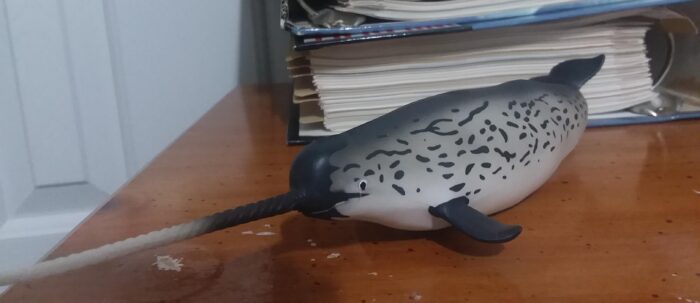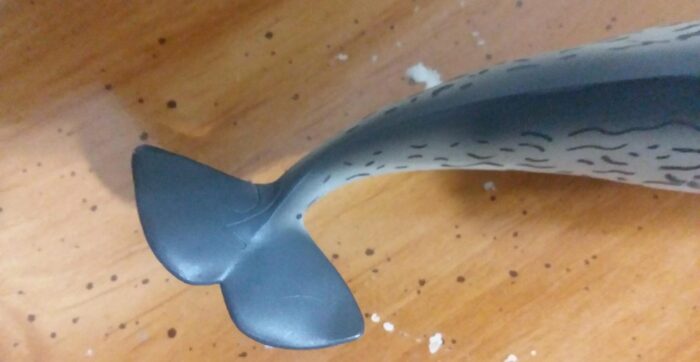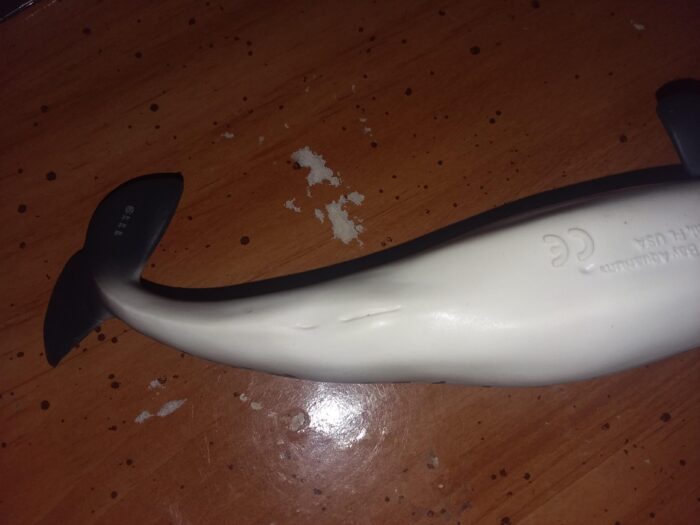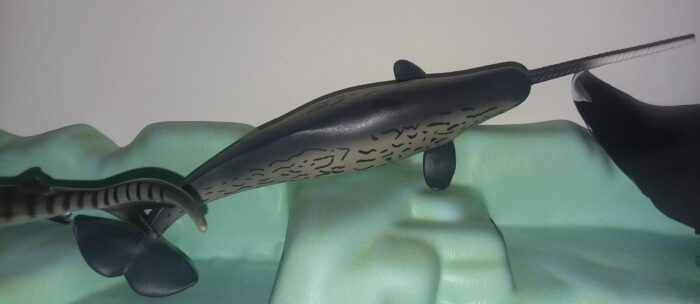For me, there are not many ”normal” whale species. Most either look normal until you learn more about them or openly advertise their weirdness like the narwhal (Monodon monoceros). The narwhal is the only extant member of its genus and its closest relative is the beluga (Delphinapterus leucas), both belonging to the Monodontidae family. Narwhals live in the Arctic waters of Greenland, Eastern Canada, and Russia, with few stragglers near Alaska and lower latitudes. As its genus and species name allude to, narwhals are distinguished by the tusk present in all males and a small minority of females. There are many theories regarding its function, ranging from stunning prey or even being a sensory organ. However, these explanations undermine the fact that tusks are generally absent in females, who are also longer-lived than males. This suggests that any sensory or foraging role of the tusk is not crucial for survival and its primary function pertains to male competition. Occurrences of broken tusks and scarring on male’s heads during the mating season support that tusks are used aggressively. Upon physical maturity, female narwhals average 3.96 meters and 904 kilograms while males average 4.57 meters and 1,645 kilograms; the largest males approach 5 meters and 1800 kilograms. The tusk typically approaches 2 meters long but may reach 3 meters in exceptional cases. Classified as ‘Least Concern’, narwhals have a global estimate of 170,000 but are thought to be very sensitive to climate change due to habitat degradation. Other threats include overfishing of prey species and boat strikes. Despite some attempts, narwhals never took off in captivity as well as belugas. Narwhals prey on halibut, cod, shrimp, and squid. Predators include killer whales and polar bears; younger individuals may be threatened by walruses and Greenland sharks. Analyses from a skull collected from a subsistence hunter revealed the occurrence of hybridization with belugas.

The Monterey Bay Aquarium collection makes another appearance on the blog after the recently reviewed whale shark. Released in 1998, the narwhal was the penultimate addition to this collection, followed up by the giant squid in 1999. Besides an old TOOB figure, this is the only narwhal I have in my collection.

The narwhal is marketed at the 1:20 scale, much like the majority of the MBA collection. The figure is 18cm long when excluding the tusk, scaling it to a 3.6-meter individual. The tusk is 7cm, which corresponds to 1.4 meters. Unlike the other MBA figures, which scale to physically mature individuals, this narwhal is closer to the size of a male just entering sexual maturity. The MBA narwhal fits closer to the 1:24-1:28 range for physically mature narwhals. The sculpt is very nice, with correct proportions and anatomical detail.


Unlike most adult cetaceans in the MBA collection, the narwhal is anatomically male. The tusk is not the only indicator, but also the very convex trailing edges of the flukes and the lack of mammaries next to the genital slit.

The spiral pattern of the tusk is very well captured, especially where it erupts. On the CollectA figure, I find that both the tusk’s radius is too wide and that there’s too much flesh from the upper lip along the base. The tusk is somewhat flexible but isn’t particularly prone to warping. I briefly owned the older version of this figure that was made with a more rubbery material that was far more prone to warping. Fun fact: An actual narwhal’s tusk is also surprisingly flexible, being able to bend 30cm in any direction without breaking.

Generally, narwhals have a light coloration with dark mottling, which becomes lighter with age. I would say the paint scheme is technically accurate for this species, but it’s a little flat. Since I’m reviewing the refreshed version of this figure, I’m a bit disappointed it’s not much different from the original as the mottling doesn’t look too organic. This is an area that I believe later figures improved. The eyes show too much of the sclera, though not as blatantly as the whale shark. I also think the tusk is too pearly white, it ought to look more tan or brown. Nonetheless, I wouldn’t consider this paintjob as horribly inaccurate as some other figures as I’ve reviewed before. I still think it’s alright, but not great.

In summation, I firmly believe the MBA narwhal is still the best in production at this scale. I find that the sculpt, specifically around the face and tusk, grants the MBA figure an edge over the current Papo and CollectA figures. So other than the average paintjob, there’s little about this figure that I consider outdated or inferior over modern ones. The MBA narwhal is still in production, and to date, remains Safari Ltd’s only narwhal other than a TOOB figure.
Disclaimer: links to Ebay and Amazon on the AnimalToyBlog are affiliate links, so we make a small commission if you use them. Thanks for supporting us!




May get it to replace my collectA one
I went with CollectA. I cannot remember why; I remember it being a challenge to find a good narwhal in the size range I wanted. I could have been that this one wasn’t readily available anywhere at the time or if it was I might have considered it too big. Can’t remember.